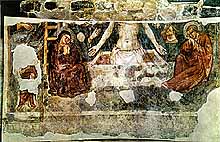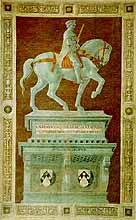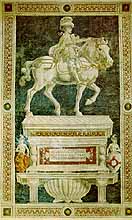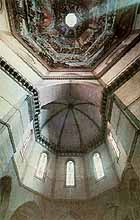
Fresco in S.Reparata (1350 ca.)
Excusez nous mais cette page n'est pas été encore traduite en Français
If we exclude the traces of the 13th-14th century frescoes that can still be seen in the righthand transept and among the remains of Santa Reparata, the few examples of painting in the interior of the Cathedral all date from the Renaissance and the late Mannerist period. The lefthand nave is dominated by the "imitation" equestrian monuments to two commanders who had rendered valuable wartime service to the Florentine Republic: the Englishman John Hawkwood (Italianized into Giovanni Acuto) and Niccolò da Tolentino. The former is by Paolo Uccello (1436), while the latter, inspired by the first, is by Andrea del Castagno (1456) and probably his last work.

Paolo Uccello,
monument to
Sir John Hawkwood
Both frescoes have been transferred onto canvas. The two frescoes are based on completely different pictorial concepts. Paolo Uccello painted the horse and knight with a sort of idealised and almost cubist "synopsis" of the various parts that compose the two figures. Two main colours, red and green, are used to create a series of curves: the neck, the rump and the belly of the horse are formed by circles, and the man dividing the horse in two parts is drawn with wheel-shapes, dots and half-spheres. This method is also clearly employed in the great Battle of San Romano (1435) in the Uffizi. The purchasers were not at all pleased with the fresco: on June 28th 1436 the artist received orders to destroy it and even Donatello reproached his friend for having drawn such a dead-looking horse. In the end Paolo had to gave way to please the public, incapable of understanding his purity of form, and had to touch up the fresco; however a drawing in the Uffizi gives a clear indication of his original intentions which anticipate many of the much more recent artistic experiences of the 20th century.

Andrea del Castagno,
monument to Niccolò da Tolentino
The fresco that Andrea del Castagno was to paint twenty years later already shows traces of the crisis in Florentine painting: while Paolo took such inordinate care over the play of perspective until it eventually became the most important element in his painting, Andrea added all his power of line and, like Pollaiolo later, made drawing become the basic origin of all his creative inspiration and not simply an abstraction of the mind.

The frescoes in the Cupola
The frescoes for the cupola by Brunelleschi, whose huge surface (4.000 sq. metres) was originally designed to be covered in mosaics like those in the Baptistery, were to be a much more exacting and enormous undertaking. The chosen subject was the Last Judgement and its execution was entrusted to Giorgio Vasari (1572-74), who followed the scrupulous iconographic Counter Reformation formula created by Don Vincenzo Borghini, Director of the Ospedale degl'Innocenti. On Vasari's death, the work was passed on to painter Federico Zuccari, who completed it between 1576 and 1579.
